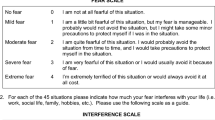Abstract
Fear of anxiety, the fear of developing physiological symptoms associated with anxiety, is investigated in this study and the extent to which fear of anxiety is differentially present in the various subtypes of specific phobias. Participants were 260 undergraduate students divided into those having fears corresponding to one of the specific phobia types and those having no reported fears. Participants completed a variety of measures including the Agoraphobic Cognitions Questionnaire and the Body Sensations Questionnaire. Results indicated fearful participants had more fear of anxiety than non-fearful participants. In addition, non-fearful participants reported significantly less frequent catastrophic cognitions than fearful participants of the situational and other types. Non-fearful control participants also reported less fear of bodily sensations than fearful participants of the animal and other subtypes. This study provides supporting evidence that the phenomenon of fear of anxiety is present in fears similar to specific phobias.
Similar content being viewed by others
References
American Psychiatric Association. (2000). Diagnostic and statistical manual of mental disorders—Text Revision (4th ed.). Washington, DC: Author.
American Psychological Association. (1992). Ethical principles of psychologists and code of conduct. American Psychologist, 47, 1597–1611.
Antony, M. M., & Barlow, D. H. (2002). Specific Phobias. In D. H. Barlow (Ed.), Anxiety and its disorders: the nature and treatment of anxiety and panic (2nd ed., pp. 380–417). New York: Gilford Press.
Antony, M. M., Brown, T. A., & Barlow, D. H. (1997). Heterogeneity among specific phobia types in DSM-IV. Behaviour Research and Therapy, 35, 1089–1100.
Arrindell, W. A. (1993). The fear of fear concept: evidence in favor of multidimensionality. Behaviour Research and Therapy, 31, 507–518.
Asmundson, G. J. G., Norton, G. R., Lanthier, N. J., & Cox, B. J. (1996). Fear of anxiety: do current measures unique aspects of the construct? Personality and Individual Differences, 20, 607–612.
Brown, T. A., DiNardo, P. A., & Barlow, D. H. (1994). Anxiety disorders interview schedule for DSM-IV. Oxford University Press
Carlbring, P., Brunt, S., Bohman, S., Austin, D., Richards, J., Öst, L. G., et al. (2007). Internet vs. paper and pencil administration of questionnaires commonly used in panic/agoraphobia research. Computers in Human Behavior, 23, 1421–1434.
Chambless, D. L., Caputo, G. C., Bright, P., & Gallagher, R. (1984). Assessment of fear of fear in agoraphobics: the body sensations questionnaire and the agoraphobic cognitions questionnaire. Journal of Consulting and Clinical Review, 52, 1090–1097.
Craske, M., & Sipsas, A. (1992). Animal phobias versus claustrophobias: Exteroceptive versus interoceptive cues. Behaviour Research and Therapy, 30, 569–581.
Geer, J. H. (1965). The development of a scale to measure fear. Behaviour Research and Therapy, 3, 45–53.
Goldstein, A. J., & Chambless, D. L. (1978). A reanalysis of agoraphobia. Behavior Therapy, 9, 47–59.
Liddell, A., & Hart, D. (1992). Comparison between FSS-II scores of two groups of university students sampled 15 years apart. Behaviour Research and Therapy, 30, 125–131.
Reiss, S., & McNally, R. J. (1985). Expectancy model of fear. In S. Reiss & R. R. Bootzin (Eds.), Theoretical Issues in Behavior Therapy (pp. 107–121). Orlando, FL: Academic Press, Inc.
Reiss, S., Peterson, R. A., Gursky, D. M., & McNally, R. J. (1986). Anxiety sensitivity, anxiety frequency, and the prediction of fearfulness. Behaviour Research and Therapy, 24, 1–8.
Zlomke, K. R., & Davis III, T. E. (2006, November). Equivalency of internet-administered screen for specific phobias and the clinician-administered ADIS-IV. Poster presented at the annual meetings of the Association for Behavioral and Cognitive Therapies, Chicago, Illinois.
Acknowledgements
The authors would like to thank Thomas H. Ollendick, Ph.D. for his consultation with this online research project.
A portion of these data were presented at the annual convention of the Association for Behavioral and Cognitive Therapies.
Author information
Authors and Affiliations
Corresponding author
Rights and permissions
About this article
Cite this article
Reuther, E.T., Davis, T.E., Grills-Taquechel, A.E. et al. Fear of Anxiety in Fearful Adults: An Analysis of Heterogeneity Among Phobia Types. Curr Psychol 30, 268–274 (2011). https://doi.org/10.1007/s12144-011-9112-3
Published:
Issue Date:
DOI: https://doi.org/10.1007/s12144-011-9112-3




